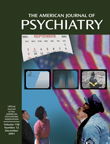Continuation of Clozapine After Priapism
Mr. A was a 25-year-old Hispanic man who suffered from unrelenting paranoia, hallucinations, and negative symptoms. Trials of traditional neuroleptics, risperidone, and olanzapine were attempted. Risperidone was discontinued after one episode of priapism and poor response to treatment. Olanzapine was only minimally effective. When he was taking clozapine, 400 mg/day, Mr. A showed remarkable improvement and was able to seek and maintain employment.Ten months into treatment, Mr. A had a painful, prolonged erection that lasted 33 hours. Nonsurgical methods were unsuccessful in relieving his discomfort. Placement of a cavernosal glandular shunt was required for detumescence. After Mr. A had recovered, various antipsychotic treatment options were offered to him. Both he and his family felt that the benefits of clozapine outweighed the risk of priapism. Given the refractory nature of his illness as well as the severity of his symptoms at decompensation, he continued to take clozapine at one-half the original dose. Except for one episode of noncompliance and subsequent decompensation, Mr. A has continued to do well and has had only residual negative symptoms. The previous episode of priapism resolved, and Mr. A has reported no recurrence of priapism in over a year.
References
Information & Authors
Information
Published In
History
Authors
Metrics & Citations
Metrics
Citations
Export Citations
If you have the appropriate software installed, you can download article citation data to the citation manager of your choice. Simply select your manager software from the list below and click Download.
For more information or tips please see 'Downloading to a citation manager' in the Help menu.
View Options
View options
PDF/EPUB
View PDF/EPUBGet Access
Login options
Already a subscriber? Access your subscription through your login credentials or your institution for full access to this article.
Personal login Institutional Login Open Athens loginNot a subscriber?
PsychiatryOnline subscription options offer access to the DSM-5-TR® library, books, journals, CME, and patient resources. This all-in-one virtual library provides psychiatrists and mental health professionals with key resources for diagnosis, treatment, research, and professional development.
Need more help? PsychiatryOnline Customer Service may be reached by emailing [email protected] or by calling 800-368-5777 (in the U.S.) or 703-907-7322 (outside the U.S.).

